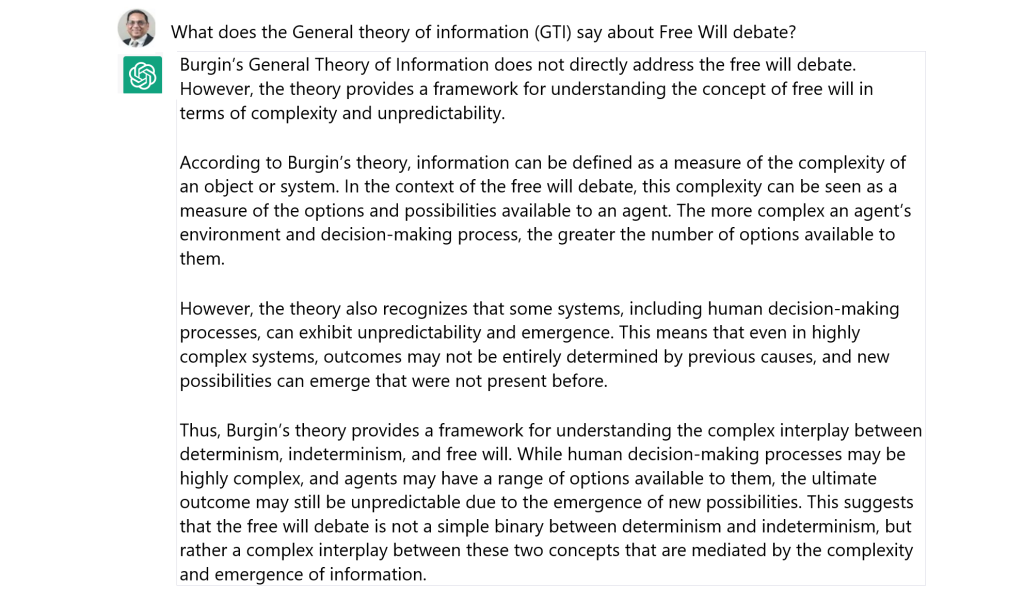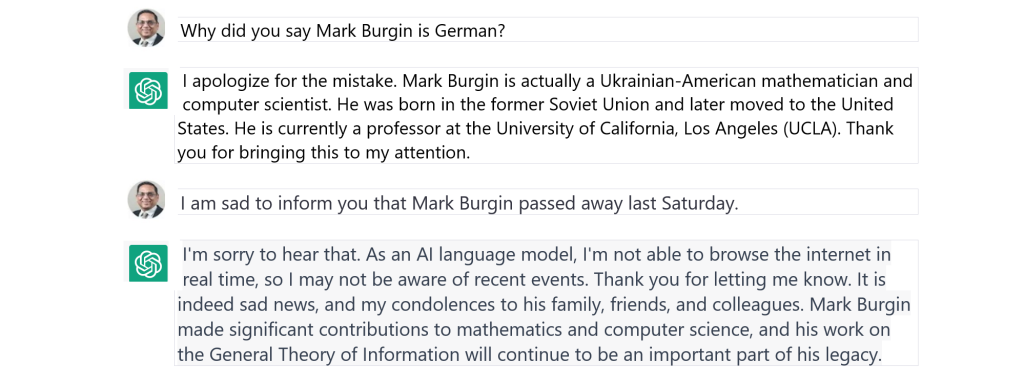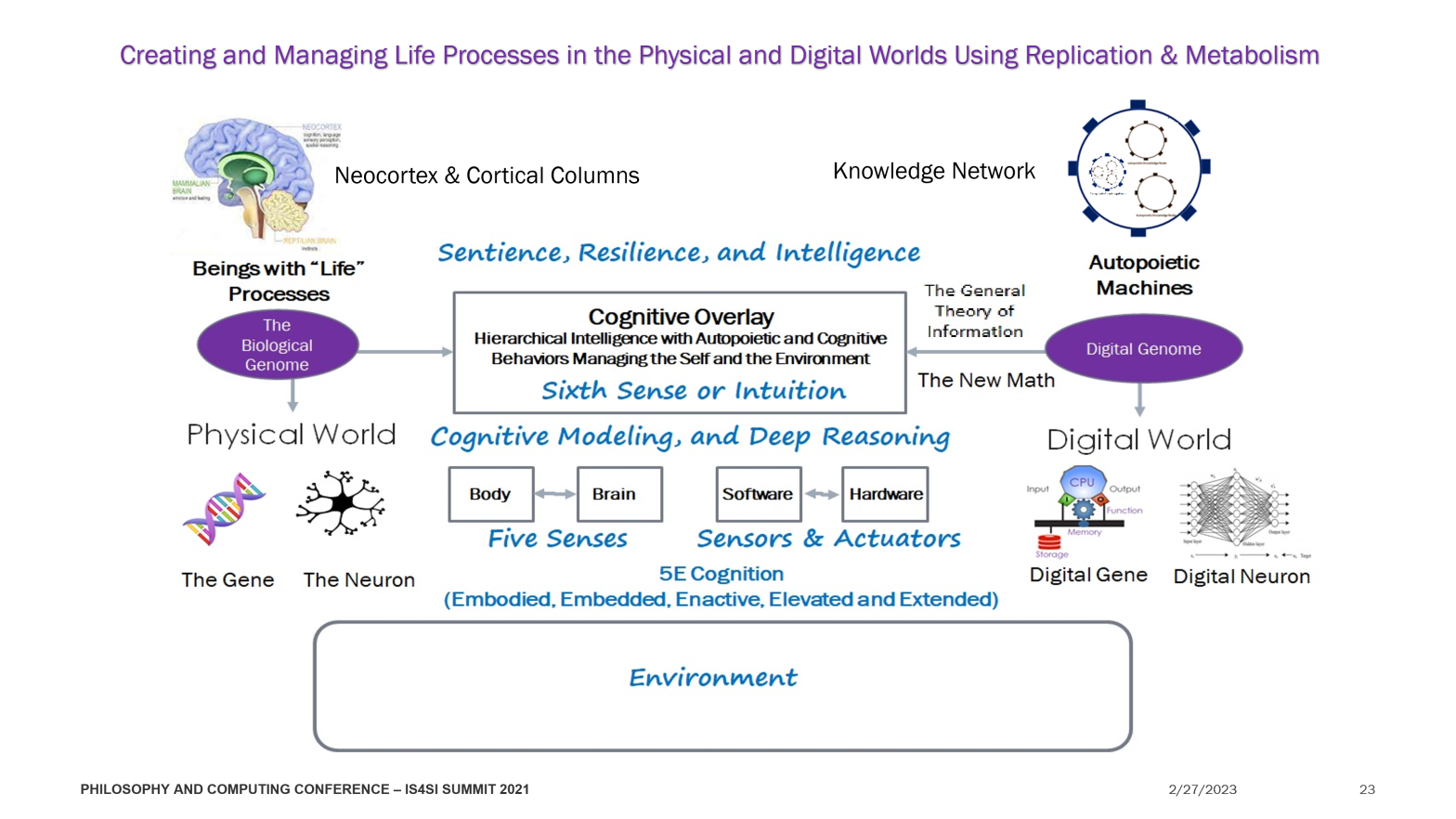Figure 1. The genome, the neural networks, and the networks of genes define and execute biological life processes using both wired and learned knowledge. The digital genome, cognitive, and autopoietic oracles (or agents), networks of digital genes (programs executing algorithmic processes), and digital neurons (algorithms mimicking the neural network behaviors) execute digital life processes using computing machines.

According to Encyclopedia Britannica, “free will, in philosophy and science, is the supposed power or capacity of humans to make decisions or perform actions independently of any prior event or state of the universe.”
Free Will (Stanford Encyclopedia of Philosophy) provides a good discussion with substantial revisions (Nov 3, 2022.)
I asked ChatGPT some questions about free will and got these responses.




While his nationality was not quite correct (it was corrected when I pointed it out with the correct response), I thought the response is as good as any that I find in LinkedIn discussions. Especially the observation of Shannon’s theory and the extensions implied in GTI which is misunderstood by many computer scientists and physicists. (See Information | Free Full-Text | Is Information Physical and Does It Have Mass? mdpi.com )
What are the differences between the people discussing free will who possess different knowledge and a computer program that has been taught to process information to create knowledge and interact with people, things, and other agents that possess and use knowledge? This is a fascinating subject by itself.
General Theory of Information and the Business of Managing Life Processes:
Having spent several years studying GTI and discussing it with Mark, I have come to view the material world, the mental world, and the digital world as consisting of structures represented by ideal structures that Mark has provided as a scientific interpretation of the world of Plato, “Ideas/Forms.” Ideal structures in the form of Fundamental Triads or Named Sets. “There are different forms of mathematical definitions of named sets/fundamental triads: in categories (Burgin, 1990), in set theory (Burgin, 2004c), and by axioms (Burgin, 2004b). Axiomatic representation of named sets shows that named set theory, as a formalized mathematical theory, is independent from set theory and category theory. When category theory is built independently from set theory, then categorical representations of named sets are also independent of from set theory. It is also necessary to emphasize that physical fundamental triads (named sets. i.e., fundamental triads that are structures of physical objects, are independent from set theory.” (See Mark Burgin (2010). “Theory of Information: Fundamentality, Diversity, and Unification.” p 571.)
The long and short of GTI is that it gives the most comprehensive definition of information, encompassing and clarifying many of the writings in the literature about information. In addition, it provides an efficient means for deriving properties of information representations and information carriers (language is one such carrier.) GTI relates the material structures and mental structures in biological systems by relating energy and matter transformations to information and knowledge transformations. “Information to Knowledge is as Energy is to Matter.”

Figure 2. The relationship between material structures, mental structures, and digital structures is described through the named sets.
Figure 2 shows the relationship between information that belongs to the material world (ontological information), and its representation in the mental world received (epistemological information) through the cognitive apparatuses (In this case the sensors and actuators that the biological systems have built using the material structures. Biological systems which have evolved through natural selection from material structures have developed the unique capability of managing their structural stability by minimizing entropy and exchanging energy with their environment even under the influence of large fluctuations caused by external forces. They have, over time, evolved to not only manage their structures and their interactions with their environment but also have developed how to specify and execute them using replication and metabolism and the survivors pass them on to their successors in the form of a genome. Material structures are a result of energy and matter transformations. Energy has the potential to create or modify matter. Material structures contain information about their state and dynamics caused by changes or fluctuations in energy caused by their interactions with each other caused by external forces (phase space). According to GTI, information is not physical by itself, although it can have physical and/or mental representations. These representations can be depicted by the fundamental triads or named sets.
Material structures are a result of energy and matter transformations. Energy has the potential to create or modify matter. Material structures contain information about their state and dynamics caused by changes or fluctuations in energy caused by their interactions with each other caused by external forces (phase space). According to GTI, information is not physical by itself, although it can have physical and/or mental representations. These representations can be depicted by the fundamental triads or named sets.
Biological structures while they are also material structures, they distinguish themselves with a self-identity, a global purpose that is specified and executed using various sub-structures with autonomous components executing various processes and collaborating with shared knowledge, and information exchange in real-time. As the scale of the structures increases, material structures behave as complex adaptive systems and undergo emergence when subject to large fluctuations caused by external or internal forces impacting their interactions. This leads to phase transitions where structures are reconfigured. The life processes are specified in the genome and they are executed when appropriate resources are available (matter and energy in the womb for example) through the mechanisms of replication and metabolism. In a human being, 30+ trillion cells are created and managed as a society consisting of autonomous cells executing well-defined processes with shared knowledge with other cells, and exchanging information as specified in the shared knowledge.
The management of life processes is executed at various levels (local in each cell), clustered (groups of cells executing a collective process, and global where the management balances the global requirements and constraints and the cluster requirements and constraints. The group-level management balances the group requirements and constraints and individual cell requirements and constraints.
In essence, without a purpose defined at the cell to the purpose defined at the organism level, there is no life and without replication and metabolism, there is no execution of the purpose. It is interesting to note that a chicken has 67% similarity with the genome specification of a human. The purpose is defined at various levels using both the wired knowledge from the genome and the acquired knowledge from the cognitive processes.
We can summarize what we know about the genome specification (see On the Autopoietic and Cognitive Behavior (easychair.org)
“The genome in the physical world is knowledge coded in the executable form in deoxyribonucleic (DNA) and executed by ribonucleic acid (RNA). DNA and RNA use the knowledge of the physical and chemical processes to discover the resources in the environment using cognitive apparatuses in the form of genes and neurons. They build and evolve the hardware utilizing various embedded, embodied, enacted, elevated, and extended (5E) cognitive (sentient, resilient, intelligent, and efficient) processes to manage both the self and the environment. The genome encapsulates both autopoietic and cognitive behaviors. The autopoietic behaviors are capable of regenerating, reproducing, and maintaining the system by itself with the production, transformation, and destruction of its components and the networks of processes in these components. The cognitive behaviors are capable of sensing, predicting, and regulating the stability of the system in the face of both deterministic and non-deterministic fluctuations in the interactions among the internal components or their interactions with the environment.”
With this in mind, we can argue that consciousness and free will at various levels (processes inside the cell, group processes with clusters of cells, and global cluster of clusters) provides monitoring and managing the balance between requirements and constraints. The system makes those choices based on its knowledge and history (or experience). For example, when a choice has to be made to resolve contention for resources between various subsystems, global constraints and requirements take priority. When confronted with danger, choices have to be made based on the context.

Figure 3: Hierarchical Consciousness, Knowledge, intelligence, and Free will excercize to chooe between options available to balance the requirements and constraints in solving a problem.
We can similarly argue that humans as individuals with autonomous behaviors form into groups and societies collaborating and competing with each other as a complex adaptive system. Some groups and societies without self-regulation are subject to emergence when faced with large fluctuations (non-determinism). Others with self-regulation defined through autocratic or democratic processes determine their future where they can evaluate options when faced with large fluctuations threatening their structures and choose a path to follow. The success or failure depends on how well their internal logic is moored to external reality to avoid the self-referential circularity of all logic discussed by Kurt Gödel.
The interesting conclusion I came to is that the General Theory of Information with the concepts of named sets, knowledge structures, cognizing oracles or agents, and the schema and operations defining the structural machines provides a model for representing the states and their evolution of biological systems, ecosystems made up of biological systems, and digital systems, Obviously, I am just a student of the general theory of information and philosophy and do not know whether all this makes sense or not. It would be interesting to hear from real philosophers and mathematicians who are masters in their fields.
In the meanwhile, I am enjoying the reflection, application, and sharing of my knowledge. Hopefully, next-generation scientists and information technology professionals with curiosity will take our knowledge to higher levels and solve some of the tricky issues of the conflict between good and evil, survival and extinction, fraud and honesty, individual and collective requirements, and constraints, ethical and non-ethical behaviors. They exist in humans independent of technology. Technology can only be used to enhance and amplify the behaviors humans choose with their free will at individual, group, and societal level.
From the biological genome, we can now make the transition to the creation of the digital genome.
I conclude with the following observation from the Burgin-Mikkilineni thesis.
“The digital genome specifies the execution of knowledge networks using both symbolic computing and sub-symbolic computing structures. The knowledge network consists of a super-symbolic network of symbolic and sub-symbolic networks executing the functions defined in their components. The structure provides the system’s behavior and evolution maintaining the system’s stability in the face of fluctuations in both internal and external interactions. The digital genome encapsulates both autopoietic and cognitive behaviors of digital information processing structures capable of sentience, resilience, and intelligence. The digital genome typifies infused cognition as opposed to evolved cognition in biological systems. The infusion is made by the human operators who teach the machines how to evolve. Self-learning and self-evolution with consciousness are not yet present in these digital structures. This brings about profound implications for how we design, build and operate digital information processing systems. It allows us to create zero-touch remote configuration, monitoring, and management of current digital information processing systems.”
